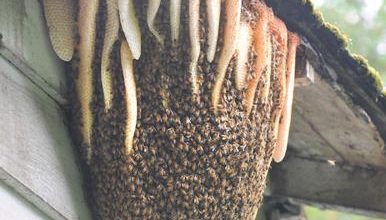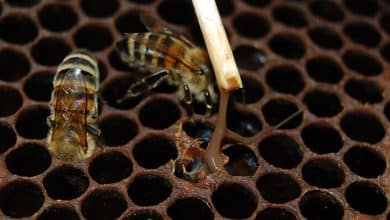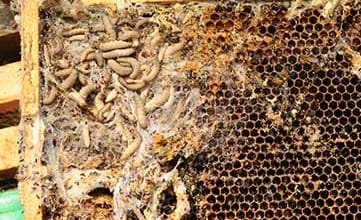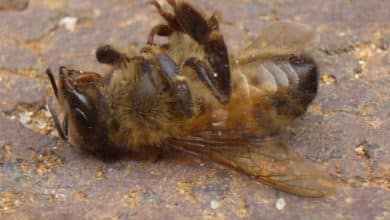Understanding Nosema Disease Causes, Symptoms, and Prevention

Nosema Disease is a serious condition that affects honeybees, particularly the European honey bees and queen bees. It is caused by a microscopic parasite known as Nosema apis. In some years, Nosema disease can lead to significant losses of adult bees and entire colonies, especially during the autumn and spring seasons.
This disease is characterized by the presence of spores of the Nosema apis organism, which can only be observed under a light microscope. These spores can be transmitted through contaminated food or water sources, and they infect the intestinal tracts of the bees.
Understanding Nosema Disease is of utmost importance for beekeepers and researchers alike. The impact of this disease on bee health and colony strength is significant. Infected bees experience a breakdown in their digestive system, leading to malnutrition and a weakened immune response. This, in turn, makes bees more susceptible to other diseases and pests, ultimately compromising the overall health of the colony.
The effects of Nosema Disease extend beyond the individual bees and can have detrimental consequences for honey production and colony survival. Infected bees may have reduced foraging capabilities, resulting in decreased honey yields. Additionally, weakened colonies are more prone to collapse, further contributing to the decline in bee populations and the potential loss of important pollinators.
To prevent and control Nosema Disease, proper hygiene practices and hive management techniques are crucial. Beekeepers must ensure clean and hygienic conditions within the hive, including regular cleaning of equipment and preventing cross-contamination. Medications and treatments specifically designed to combat Nosema can also be utilized, although they should be used judiciously and in accordance with recommended guidelines.
Ongoing research and advancements in both beekeeping associations and scientific studies are being made to better understand Nosema Disease and develop effective treatment methods. Innovations in breeding resistant bees and the development of targeted treatments show promising potential in mitigating the impact of Nosema Disease.
Overall, early detection and proactive management strategies are essential in the prevention and control of Nosema Disease. By prioritizing sustainable beekeeping practices and fostering a healthy bee population, we can protect these vital pollinators and ensure the continued flourishing of our ecosystems.
What is Nosema Disease and its impact on bees
Nosema Disease is a significant threat to honeybees, particularly the European honey bees and queen bees. It is caused by a microscopic parasite known as Nosema apis. This parasitic organism invades the intestinal tracts of bees, resulting in a breakdown of their digestive system.
The impact of Nosema Disease on bees is profound. Infected bees suffer from malnutrition, as their impaired digestive system prevents them from properly extracting nutrients from their food. This leads to weakened immune responses, making the bees more vulnerable to other diseases and pests. Ultimately, Nosema Disease compromises the overall health and vitality of the colony.
The effects of Nosema Disease are not limited to individual bees, but they also extend to the entire colony. Infected bees exhibit reduced foraging capabilities, leading to decreased honey production and overall colony strength. Weakened colonies are more susceptible to collapse and are at a higher risk of succumbing to other environmental stressors.
To mitigate the impact of Nosema Disease, beekeepers must prioritize good hygiene practices and effective hive management techniques. This includes regular cleaning of equipment and preventing cross-contamination. In some cases, medications and treatments specifically designed to combat Nosema can be employed, although their use should be in accordance with recommended guidelines to avoid potential resistance issues.
Research and advancements are continuously being made to better understand Nosema Disease and develop targeted treatment methods. Breeding bees resistant to Nosema and the development of innovative treatments show promise in mitigating the impact of this disease.
In conclusion, early detection and proactive management strategies are crucial in preventing and controlling Nosema Disease. By prioritizing sustainable beekeeping practices and fostering a healthy bee population, we can protect these essential pollinators and ensure the continued flourishing of our ecosystems.
Importance of understanding the causes, symptoms, and prevention of Nosema Disease
Understanding the causes, symptoms, and prevention of Nosema Disease is of utmost importance in ensuring the health and survival of honeybee populations. This knowledge allows beekeepers to take proactive measures to prevent the spread of the disease and protect their colonies. It also enables researchers and scientists to develop effective treatments and management strategies.
By understanding the causes of Nosema Disease, beekeepers can identify and address the factors that contribute to its spread. They can implement proper hygiene practices, such as regular cleaning of equipment and minimizing the risk of cross-contamination. Additionally, understanding the different strains of Nosema, such as Nosema apis and Nosema ceranae, helps beekeepers tailor their management approaches to specific circumstances.
Recognizing the symptoms of Nosema Disease allows for early detection and intervention. Beekeepers can closely monitor their colonies for signs, such as dysentery, reduced brood production, and decreased honey production. Identifying these symptoms early on enables beekeepers to take swift action, preventing further transmission and minimizing the impact on overall colony health.
Prevention is key in managing Nosema Disease. By implementing preventive measures, such as providing adequate nutrition and maintaining optimal hive conditions, beekeepers can create an environment that reduces the risk of infection. This includes practices like providing pollen substitutes during times of pollen scarcity and avoiding the use of inappropriate pesticides.
Overall, understanding the causes, symptoms, and prevention of Nosema Disease is essential for the long-term viability of honeybee populations. By staying informed and implementing appropriate management strategies, beekeepers can mitigate the impact of the disease and contribute to the health and well-being of bees.
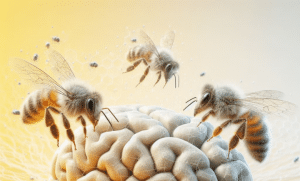
Causes of Nosema Disease
Nosema Disease is caused by two species of microsporidian parasites, Nosema apis and Nosema ceranae. These microscopic parasites infect the intestinal tract of honeybees, leading to the development of Nosema Disease.
Nosema apis has been known to be a longtime resident of honeybee colonies, while Nosema ceranae is a newer and more prevalent strain that has gained prominence in recent years. Both species of Nosema are highly contagious and can spread rapidly through an apiary.
The primary mode of transmission for Nosema Disease is through the ingestion of spores present in contaminated food or water sources. Infected bees excrete spores in their feces, which can contaminate hive surfaces, honey, and other resources. Bees coming into contact with these contaminated surfaces can then consume the spores, further spreading the disease within the colony.
Various factors contribute to the susceptibility and prevalence of Nosema Disease. Environmental stressors, such as inadequate nutrition, cold temperatures, and poor hive conditions, can weaken the immune system of honeybees, making them more vulnerable to infection.
Additionally, certain management practices, such as overcrowding, improper sanitation of equipment, and the use of inappropriate pesticides, can increase the risk of Nosema infestation.
Overall, understanding the causes of Nosema Disease is crucial for effective prevention and control. By implementing measures to reduce exposure to the parasites and promoting healthy hive conditions, beekeepers can minimize the risk of Nosema infection and protect the well-being of their honeybee colonies.
Nosema apis: a microscopic parasite affecting honeybees
Nosema apis is a microscopic parasite that has long been known to affect honeybees. This spore-forming fungus infects the intestinal tract of bees, leading to a disease known as Nosema Disease.
The spores of Nosema apis are ingested by bees when they consume contaminated food or water sources. Once inside the bee’s gut, the spores germinate and release cells that invade the cells lining the gut. This invasion disrupts the normal functioning of the bee’s digestive system, causing damage to the intestinal lining and interfering with nutrient absorption.
Infected bees often exhibit symptoms such as dysentery, which is characterized by the presence of fecal matter on the exterior of the hive and around the entrance. Bees with Nosema apis may also have reduced lifespan and decreased overall health, leading to weaker colonies and lower honey production.
Nosema apis is particularly prevalent during periods of environmental stress, such as cold temperatures or inadequate nutrition. These stressors weaken the immune system of honeybees, making them more susceptible to infection.
Preventing the spread and impact of Nosema apis involves implementing good management practices. Proper hive hygiene, including regularly cleaning and disinfecting equipment, can help reduce the risk of infection. Providing bees with a balanced and nutritious diet can also enhance their immune system and make them more resistant to Nosema apis.
In conclusion, Nosema apis is a microscopic parasite that poses a threat to honeybee health. By understanding the causes and symptoms of Nosema Disease and implementing appropriate prevention measures, beekeepers can protect their colonies and promote the overall well-being of honeybees.
Nosema ceranae: a newer and more prevalent strain of Nosema
Nosema ceranae is a more recent strain of Nosema and has become increasingly prevalent in honeybee populations worldwide. This strain is believed to have originated in Asian honey bees (Apis cerana) and has now spread to European honey bees.
Nosema ceranae has several characteristics that make it particularly concerning. One key aspect is its ability to reproduce rapidly, leading to a higher parasite load within infected bees. This higher parasite load can have a more severe impact on the digestive system of bees, leading to more significant health issues.
Moreover, Nosema ceranae has been found to be more resistant to certain medications commonly used to treat Nosema infections. This resistance poses a challenge for beekeepers attempting to control and manage the disease.
The increased prevalence of Nosema ceranae has been attributed to several factors. International trade and the movement of beehives across different regions have facilitated the spread of this strain. Additionally, changes in temperature patterns and the shifting of forage availability due to climate change have created favorable conditions for the establishment and spread of Nosema ceranae.
It is essential for beekeepers to be aware of the presence of Nosema ceranae in their colonies and take proactive measures to prevent its spread. This can include regular monitoring and testing of bee populations, implementing good hygiene practices, providing adequate nutrition to strengthen the bees’ immune systems, and considering alternative treatments that may be effective against this strain.
Continued research and collaboration among beekeepers, scientists, and beekeeping associations are crucial for better understanding Nosema ceranae and developing effective strategies for its control and management. By staying informed and implementing appropriate measures, beekeepers can help mitigate the impact of this increasingly prevalent strain of Nosema on honeybee health and colony productivity.
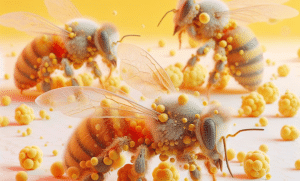
Symptoms and effects of Nosema Disease
Nosema Disease, caused by the microsporidian parasites Nosema apis and Nosema ceranae, can have significant symptoms and effects on honeybees. It is important for beekeepers to be able to recognize these signs in order to take appropriate actions for the health and survival of their colonies.
One of the primary symptoms of Nosema Disease is digestive system breakdown in infected bees. The parasites invade the cells lining the bees’ midgut, leading to impairment of digestion and nutrient absorption. This can result in dysentery, with bees exhibiting diarrhea-like symptoms and leaving behind fecal stains on hive surfaces.
Besides the digestive system, Nosema Disease can have detrimental effects on colony strength, honey production, and overall survival. Infected bees may experience reduced lifespan and decreased brood production, leading to a decline in population size. Honey production can also be significantly affected, as infected bees struggle to forage and gather nectar.
Furthermore, Nosema Disease can weaken the immune system of bees, making them more susceptible to other diseases and pests. This can further compromise the overall health of the colony and its ability to withstand various stressors.
Prevention and control measures, such as good hygiene practices and the use of medication, are crucial in mitigating the impact of Nosema Disease. Regular monitoring and testing of bee populations can help detect the presence of Nosema and allow for timely intervention. Providing a balanced diet and ensuring optimal hive conditions can also strengthen the bees’ immune systems and reduce their vulnerability to Nosema infection.
In conclusion, understanding the symptoms and effects of Nosema Disease is crucial for beekeepers to protect the health and productivity of their colonies. Early detection, regular monitoring, and proactive management are key to minimizing the impact of this disease and promoting bee well-being.
Digestive system breakdown and impact on bee health
Nosema Disease, caused by the microsporidian parasites Nosema apis and Nosema ceranae, primarily affects the digestive system of honeybees, leading to significant health implications. The parasites invade the cells lining the bees’ midgut, resulting in a breakdown of the digestive process and impairing nutrient absorption. As a result, infected bees may experience dysentery, characterized by diarrhea-like symptoms and fecal stains left behind on hive surfaces.
The digestive system breakdown not only hinders the bees’ ability to process food but also affects their overall health and vitality. Infected bees often suffer from decreased energy levels and weakened immune systems, making them more susceptible to other diseases and pests. This vulnerability can further compromise the colony’s overall health and survival.
Furthermore, the impact of Nosema Disease extends beyond individual bees. Colony strength and productivity can be significantly affected, as infected bees may have reduced lifespans and decreased brood production. This decline in population size can weaken the colony’s ability to perform essential tasks, such as foraging and caring for the brood. Additionally, honey production may suffer as infected bees struggle to gather nectar and perform their crucial role in the honey-making process.
It is crucial for beekeepers to recognize the symptoms of Nosema Disease and take appropriate actions to mitigate its effects on bee health. Early detection, through regular monitoring and testing, allows for prompt intervention and treatment. Good hygiene practices, such as maintaining clean hives and equipment, can help reduce the spread of Nosema spores. Providing a balanced diet and optimal hive conditions can also strengthen the bees’ immune systems and make them more resistant to Nosema infection.
In conclusion, the digestive system breakdown caused by Nosema Disease significantly impacts bee health and colony productivity. Understanding the symptoms and effects of this disease allows beekeepers to implement appropriate prevention and control measures, promoting the overall well-being of the bees and the sustainability of beekeeping practices.
Negative effects on colony strength, honey production, and survival
Nosema Disease not only impacts individual bees but also has significant negative effects on the overall strength, productivity, and survival of honeybee colonies.
One of the most noticeable effects is a decline in colony strength. Infected bees have reduced lifespans and decreased brood production. This decrease in population size weakens the colony’s ability to perform essential tasks, such as foraging and caring for the brood. The overall vitality and resilience of the colony are compromised, making it more vulnerable to other diseases and pests.
Honey production is also severely affected by Nosema Disease. Infected bees struggle to gather nectar and perform their crucial role in the honey-making process. This results in a decrease in honey production, which can ultimately impact the beekeeper’s ability to harvest and sell honey.
Additionally, the survival of the entire colony is jeopardized by Nosema Disease. The weakened immune systems of infected bees make them more susceptible to other diseases and pests. Without a strong and healthy workforce, the colony is at a higher risk of facing further health issues and potential collapse.
It is essential for beekeepers to recognize and address Nosema Disease promptly to mitigate these negative effects. Regular monitoring, early detection, and appropriate intervention can help minimize colony losses and maintain honey production levels. By implementing good hygiene practices and providing optimal hive conditions, beekeepers can support the bees’ immune systems, reducing their susceptibility to Nosema infection and promoting the long-term survival and productivity of the colony.
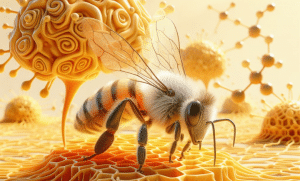
Prevention and control measures of Nosema Disease
One of the key strategies for preventing and controlling Nosema Disease in honeybee colonies is implementing proper hygiene practices and hive management techniques. These measures help create a clean and disease-free environment for the bees. Here are some important practices to consider:
- Regular hive inspections: Conduct routine inspections to identify and address any signs of Nosema infection. This may include checking for diarrhea stains on the exterior of the hive and observing the behavior and appearance of the bees.
- Adequate ventilation: Ensure that the hive has proper ventilation to prevent the buildup of humidity and moisture, which can create favorable conditions for Nosema spore growth.
- Good nutrition: Provide bees with a diverse and nutritious diet to boost their immune systems and overall health. This includes a range of floral sources and supplementary bee feed when necessary.
- Hive cleaning: Clean and sanitize hives regularly to eliminate any spores or contaminated materials. Scrub hive components with a mild, hive-friendly disinfectant and allow them to dry thoroughly before reuse.
- Rotation of comb: Consider rotating comb frames regularly to prevent the buildup of Nosema spores in older, contaminated comb. This helps reduce the risk of infection.
- Beekeeper education: Stay informed about the latest research and best management practices for Nosema Disease. Attend beekeeping workshops, read scientific studies, and engage with reputable beekeeping associations for up-to-date information and guidance.
In addition to these preventive measures, medication and treatments may be necessary in severe cases of Nosema infection. Consult with a qualified veterinarian or beekeeping expert to determine the most appropriate treatments for your specific situation.
By implementing these prevention and control measures, beekeepers can help reduce the occurrence and impact of Nosema Disease in their colonies, ensuring the health and productivity of their honeybee populations.
Hygienic practices and hive management techniques
Hygienic practices and proper hive management techniques play a crucial role in preventing and controlling Nosema Disease in honeybee colonies. By maintaining a clean and disease-free environment, beekeepers can help ensure the health and well-being of their bees. Here are some important strategies to consider:
- Regular hive inspections: Conducting routine inspections is essential for early detection of Nosema Disease. Beekeepers should check for diarrhea stains on the exterior of the hive and observe the behavior and appearance of the bees.
- Adequate ventilation: Proper ventilation in the hive is important to prevent the buildup of humidity and moisture, which can create favorable conditions for Nosema spore growth. Ensure that the hive has sufficient ventilation to promote air circulation.
- Good nutrition: Providing bees with a diverse and nutritious diet is important to boost their immune systems and overall health. Ensure there are ample floral sources available and consider supplementary bee feed when necessary.
- Hive cleaning: Regularly clean and sanitize hives to eliminate any spores or contaminated materials. Scrub hive components with a mild, hive-friendly disinfectant and allow them to dry thoroughly before reuse.
- Rotation of comb: Regularly rotate comb frames to prevent the buildup of Nosema spores in older, contaminated comb. This helps reduce the risk of infection.
By implementing these hygienic practices and hive management techniques, beekeepers can create a healthy and disease-resistant environment for their honeybees. It is important to note that prevention is key, and early detection and proactive management are crucial in controlling Nosema Disease. Regular monitoring and staying informed about the latest research and best practices are essential for successful beekeeping.
Use of medication and treatments to combat Nosema
The use of medication and treatments plays a crucial role in combating Nosema Disease in honeybee colonies. When detected, beekeepers can take proactive measures to control and manage the disease effectively. Here are some common approaches used to treat Nosema:
- Fumagillin: Fumagillin is an antimicrobial drug that has been widely used to treat Nosema infections. It works by inhibiting the growth and development of Nosema spores in the honeybee gut. Beekeepers can administer fumagillin through various methods, such as feeding it to the bees or applying it directly to the hive.
- Probiotics: Probiotics are beneficial bacteria that can help restore the natural microbial balance in the honeybee gut. Research has shown that certain probiotics have the potential to suppress the growth of Nosema spores and enhance the overall health of the bees. Beekeepers can add probiotic supplements to the honeybee diet or use probiotic-treated sugar syrup.
- Essential oils: Some essential oils, such as thyme and oregano oil, have antimicrobial properties that can help in managing Nosema Disease. These oils can be added to sugar syrup or used as a hive treatment. However, it is crucial to use essential oils in appropriate dosages and follow recommended guidelines to avoid any negative effects on the bees.
- Genetic selection: Breeding bees for resistance to Nosema Disease is another approach in combating the disease. By selecting and breeding bees that have shown resistance or tolerance to Nosema, beekeepers can develop stronger and more resilient colonies that can withstand Nosema infections.
- Environmental management: Creating a hygienic and disease-free environment is vital in preventing the spread of Nosema. This includes proper hive sanitation, regular comb rotation, and disease monitoring. Maintaining good nutrition and providing clean water sources for the bees also contribute to their overall health and resistance to Nosema.
It is important for beekeepers to consult with professionals and follow recommended guidelines when using medication and treatments to combat Nosema. The goal is to strike a balance between effective control of the disease and minimizing any negative impacts on bee health and honey production.
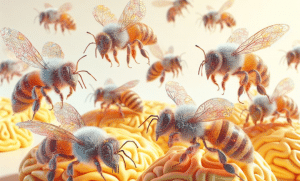
Research and advancements in tackling Nosema Disease
Beekeeping associations and scientific researchers have made significant progress in understanding and combating Nosema Disease. Through extensive studies and collaboration, they have developed innovative approaches to tackle this harmful disease and protect honeybee populations.
One notable area of research focuses on the use of genetic selection to breed resistant bees. Scientists have been identifying and breeding lines of honeybees with a natural resistance or tolerance to Nosema. This genetic selection helps in developing stronger and more resilient colonies that are less susceptible to Nosema infections. By incorporating these resistant bees into breeding programs, beekeepers can significantly reduce the impact of Nosema on their colonies.
Another promising advancement is the development of effective treatments for Nosema Disease. Researchers are exploring the use of natural compounds, such as plant-based extracts and essential oils, that have antimicrobial properties. These treatments have shown promising results in suppressing the growth of Nosema spores and improving the overall health of the honeybees. Additionally, probiotics, which are beneficial bacteria, have been found to restore the microbial balance in the honeybee gut and help combat Nosema.
Furthermore, ongoing research is focused on understanding the environmental factors that contribute to the prevalence and spread of Nosema. This knowledge enables beekeepers to implement proper hive management practices, such as regular comb rotation and hygiene, to minimize Nosema transmission.
The dedication of beekeeping associations and researchers to finding effective solutions for Nosema Disease is the key to managing and preventing its impact. With continued advancements in breeding resistant bees, developing new treatments, and promoting sustainable beekeeping practices, beekeepers can safeguard their colonies and ensure the health and vitality of honeybee populations for years to come.
Beekeeping associations and scientific studies on Nosema
Beekeeping associations and scientific researchers play a crucial role in understanding and addressing Nosema Disease. These organizations and studies are dedicated to studying the disease and finding effective solutions to prevent its spread and manage its impact on honeybees.
Beekeeping associations, such as the American Beekeeping Federation and the British Beekeepers Association, actively collaborate with researchers to provide support to beekeepers and promote best management practices for preventing Nosema infections. They offer educational resources, workshops, and conferences to raise awareness about the disease and its prevention.
Scientific studies on Nosema Disease have yielded valuable insights into its causes, transmission, and treatment options. Researchers have conducted comprehensive studies to determine the genetic factors that make certain honeybee colonies more resistant to Nosema. Through careful genetic selection and breeding programs, they aim to develop bees with improved resistance to the disease.
Furthermore, scientists have explored the impact of environmental factors, such as temperature and humidity, on the prevalence and severity of Nosema infections. These findings enable beekeepers to implement appropriate hive management practices to minimize the risk of Nosema outbreaks.
Researchers have also made significant progress in developing effective treatments for Nosema. They have studied the antimicrobial properties of natural compounds, such as plant extracts and essential oils, to develop treatments that can suppress the growth of Nosema spores. Additionally, probiotics have shown promise in restoring the microbial balance within honeybees and improving their resilience against Nosema.
Overall, the collaboration between beekeeping associations and scientific researchers is vital in advancing our understanding of Nosema Disease and developing effective strategies to prevent its impact on honeybees. By staying informed and implementing the recommended best practices, beekeepers can safeguard their colonies and contribute to the overall health and vitality of honeybee populations.
Innovations in breeding resistant bees and developing effective treatments
Beekeepers and researchers alike have been working tirelessly to develop innovative strategies to combat Nosema Disease. One such approach is focused on breeding bees that exhibit natural resistance to Nosema. Through careful genetic selection and breeding programs, scientists have identified certain honeybee colonies that have a higher resistance to Nosema. By selectively breeding these resistant colonies, they aim to develop a population of bees that are better equipped to fight off the disease.
In addition to breeding, researchers have been exploring alternative treatments for Nosema. Traditional medications and antibiotics have been used in the past, but concerns about their impact on bee health and the environment have led to the search for more sustainable options. One promising avenue is the use of natural compounds with antimicrobial properties, such as plant extracts and essential oils. These compounds have shown potential in suppressing the growth of Nosema spores and reducing the severity of infection.
Probiotics have also emerged as a potential treatment for Nosema. These beneficial bacteria can help restore the microbial balance within honeybees and strengthen their immune system, making them more resilient against Nosema. Research is ongoing to determine the most effective strains and dosage of probiotics for Nosema treatment.
The development of effective treatments and breeding resistant bees is crucial in the fight against Nosema Disease. These innovations offer hope for beekeepers who are striving to protect their colonies and ensure the long-term health of honeybee populations. By implementing these strategies, beekeepers can reduce the impact of Nosema and safeguard the future of their hives. Continued research and advancements in this field will undoubtedly play a vital role in the prevention and management of Nosema Disease.
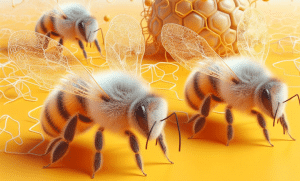
Conclusion Nosema Disease
In conclusion, Nosema Disease is a significant threat to honeybee populations and the beekeeping industry. Understanding its causes, symptoms, and prevention methods is crucial for maintaining the health and vitality of bee colonies. Nosema apis and Nosema ceranae, the two main species responsible for the disease, can have detrimental effects on bees’ digestive systems and overall colony strength.
Prevention and control measures play a critical role in managing Nosema Disease. Beekeepers should prioritize hygienic practices, such as regular hive cleaning and proper disposal of infected material, to reduce the spread of the disease. Additionally, medication and treatments can be used to combat Nosema and support colony health.
Advancements in research and innovation have provided hope in the fight against Nosema Disease. Breeding resistant bees and developing effective treatments are promising strategies to enhance the bees’ ability to resist the disease. Probiotics and natural compounds with antimicrobial properties show potential in suppressing the growth of Nosema spores and alleviating infection severity.
Early detection and proactive management are essential for preventing widespread outbreaks and minimizing the impact of Nosema Disease. Beekeeping associations and scientific studies provide valuable resources and knowledge to support beekeepers in their efforts to address this disease.
In conclusion, promoting sustainable beekeeping practices, alongside ongoing research and advancements, is crucial for preventing and managing Nosema Disease. By prioritizing the health and well-being of honeybee colonies, we can safeguard the future of these vital pollinators and ensure the sustainability of our ecosystems.
Importance of early detection and proactive management
Early detection and proactive management are crucial in the fight against Nosema Disease. By identifying and addressing the disease in its early stages, beekeepers can prevent the spread of infection and minimize its impact on bee colonies.
One of the key reasons for early detection is the potential for rapid spread within a bee colony and to other colonies in close proximity. Nosema Disease can easily be transmitted from an infected bee to healthy bees through contact with contaminated feces or contaminated surfaces within the hive. Therefore, if a case of Nosema Disease is identified early on, prompt action can be taken to isolate infected bees or colonies, preventing the disease from spreading further.
Additionally, early detection allows for timely intervention. Beekeepers can implement appropriate treatment or management strategies to address the disease and support the affected colony’s recovery. This may include administering medication, such as fumagillin, which has shown effectiveness against Nosema spores.
Proactive management plays a crucial role in preventing widespread outbreaks of Nosema Disease. Regular hive inspections and monitoring for signs of infection, such as discolored or distended abdomens and an increased number of inactive bees, are essential in catching the disease early. Beekeepers should also maintain hygienic practices, such as hive cleaning and proper disposal of infected material, to minimize the risk of Nosema transmission.
By prioritizing early detection and proactive management, beekeepers can effectively control and manage Nosema Disease, safeguarding the health and productivity of their honeybee colonies. Regular monitoring, swift action, and consistent adherence to best management practices are key to mitigating the impact of this disease.
Encouraging sustainable beekeeping practices for Nosema prevention
Encouraging sustainable beekeeping practices is vital for the prevention of Nosema Disease. By prioritizing the health and well-being of honeybee colonies, beekeepers can create an environment that minimizes the risk of Nosema infection. Here are some key practices to consider:
- Providing a diverse and nutritious forage: Ensuring bees have access to a variety of flowering plants throughout the year can enhance their immune systems and increase their resistance to diseases like Nosema. Planting bee-friendly flowers and avoiding the use of pesticides can help maintain a healthy ecosystem for bees.
- Regular hive inspections: Regular inspections allow beekeepers to monitor the overall health of their colonies and detect any signs of Nosema infection early on. By identifying the disease in its early stages, effective control measures can be implemented promptly.
- Hygienic hive management: Maintaining clean hives is crucial in preventing the spread of Nosema. Regularly cleaning hive equipment, replacing old combs, and maintaining proper ventilation can contribute to a healthy hive environment and reduce the risk of Nosema transmission.
- Queen quality and colony strength: Investing in high-quality queens, which have a strong genetic resistance to diseases, can help reduce the overall susceptibility of colonies to Nosema. Building up colony strength through good nutrition and management practices promotes overall bee health and resilience.
- Education and collaboration: Beekeepers should stay informed about the latest research and best practices for Nosema prevention. Participating in beekeeping associations, attending workshops, and sharing knowledge with fellow beekeepers can create a supportive network that promotes sustainable beekeeping practices.
By adopting sustainable beekeeping practices, beekeepers can significantly reduce the risk of Nosema Disease and contribute to the overall health and longevity of honeybee colonies. It is important to remember that preventing Nosema is an ongoing effort that requires regular monitoring, continuous learning, and collaboration within the beekeeping community.
I hope this blog post has provided you with a thorough understanding of Nosema disease, its causes, symptoms, and prevention methods. It is crucial for beekeepers and anyone interested in honey bee health to be aware of this disease and take necessary precautions to prevent its spread. If you have any further questions or insights on this topic, please feel free to share them in the comments section below. Together, let’s work towards ensuring the health and well-being of our precious honey bees.



